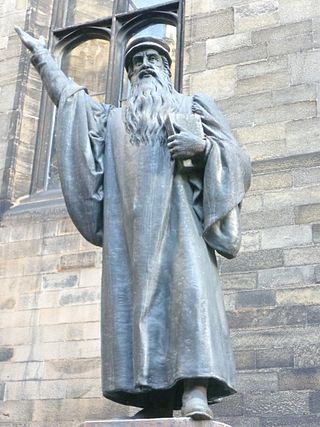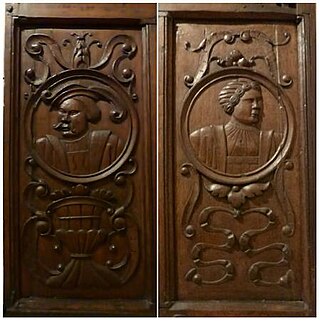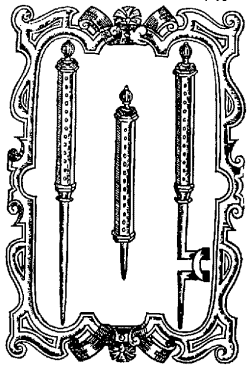Related Research Articles

The Scottish Reformation was the process by which Scotland broke with the Papacy and developed a predominantly Calvinist national church, the Church of Scotland, which was strongly Presbyterian in its outlook. It was part of the wider European Protestant Reformation that took place from the 16th century.

Agnes Sampson was a Scottish healer and purported witch. Also known as the "Wise Wife of Keith", Sampson was involved in the North Berwick witch trials in the later part of the sixteenth century.

Sir Robert Lauder of Beilmouth, Knt., was an armiger, lawyer and Clerk of Exchequer in Scotland. In 1683 he was made a Justice of the Peace for Haddingtonshire. As Robert Lauder of Belhaven he was in the old Scottish parliament for Haddington in 1685, and, as Sir Robert Lauder of Beilmouth, in 1704. He was also Commissioner of Supply for Haddington in 1689 and 1690.
The Islandmagee witch trials were two criminal trials in Carrickfergus in 1711 for alleged witchcraft at Islandmagee. It is believed to have been the last witch trial to take place in Ireland.

Balmaclellan is a small hillside village of stone houses with slate roofs in a fold of the Galloway hills in south-west Scotland. To the west, across the Ken River, the larger and more prosperous New Galloway lies below the Rhinns of Kells.

The Paisley witches, also known as the Bargarran witches or the Renfrewshire witches, were tried in Paisley, Renfrewshire, central Scotland, in 1697. Eleven-year-old Christian Shaw, daughter of the Laird of Bargarran, complained of being tormented by some local witches; they included one of her family's servants, Catherine Campbell, whom she had reported to her mother after witnessing her steal a drink of milk.

St Andrew's-by-the-Green is an 18th-century category-A-listed former church in Glasgow, Scotland. A Qualified Chapel, it was the first Episcopalian church built in the city. It is situated on the corner of Turnbull Street and Greendyke Street, overlooking Glasgow Green, on the edge of the city's East End.

Scottish society in the early modern era encompasses the social structure and relations that existed in Scotland between the early sixteenth century and the mid-eighteenth century. It roughly corresponds to the early modern era in Europe, beginning with the Renaissance and Reformation and ending with the last Jacobite risings and the beginnings of the industrial revolution.

The great Scottish witch hunt of 1649–50 was a series of witch trials in Scotland. It is one of five major hunts identified in early modern Scotland and it probably saw the most executions in a single year.

Witchcraft in Orkney possibly has its roots in the settlement of Norsemen on the archipelago from the eighth century onwards. Until the early modern period magical powers were accepted as part of the general lifestyle, but witch-hunts began on the mainland of Scotland in about 1550, and the Scottish Witchcraft Act of 1563 made witchcraft or consultation with witches a crime punishable by death. One of the first Orcadians tried and executed for witchcraft was Allison Balfour, in 1594. Balfour, her elderly husband and two young children, were subjected to severe torture for two days to elicit a confession from her.

Elspeth Reoch was an alleged Scottish witch. She was born in Caithness but as a child spent time with relatives on an island in Lochaber prior to travelling to the mainland of Orkney.

The Bute witches were six Scottish women accused of witchcraft and interrogated in the parish of Rothesay on Bute during the Great Scottish Witch Hunt of 1661–62. The Privy Council granted a Commission of Justiciary for a local trial to be held and four of the women – believed by historians to be Margaret McLevin, Margaret McWilliam, Janet Morrison and Isobell McNicoll – were executed in 1662; a fifth may have died while incarcerated. One woman, Jonet NcNicoll, escaped from prison before she could be executed but when she returned to the island in 1673 the sentence was implemented.
Maud Galt was a lesbian accused of witchcraft in Kilbarchan, Scotland.
Margaret Burges, also known as 'Lady Dalyell', was a Scottish businesswoman from Nether Cramond who was found guilty of witchcraft and executed in Edinburgh in 1629.

The Witch trials in Denmark are poorly documented, with the exception of the region of Jylland in the 1609–1687 period. The most intense period in the Danish witchcraft persecutions was the great witch hunt of 1617–1625, when most executions took place, which was affected by a new witchcraft act introduced in 1617.

Kirkcudbright Tolbooth is a historic municipal building in Kirkcudbright in Dumfries and Galloway, Scotland. Built between 1627 and 1629 to serve the town as a centre of commercial administration, a meeting place for the council, and a prison, it was used for all these roles until the late eighteenth century when the council moved much of its business to new, larger premises they had constructed across the street; the tolbooth remained in use as a prison until the early nineteenth century, after which it remained in council ownership and was put to a variety of uses.
Marie Ruthven, Countess of Atholl, was a Scottish aristocrat.
John Russell was a Scottish lawyer and author. He was involved in witch trials.
Anna Tait or Anne Tait, also known as 'Hononni', was accused of witchcraft in Haddington, East Lothian in 1634 and executed in 1635. Her case revolved around her feelings of grief and guilt which caused her suicidal thoughts for the murder of her first husband and the death of her beloved daughter following a botched home abortion.
The persecution of accused witches in Aberdeen began during the Aberdeen witch trials of 1596-1597 when forty-five women and two men were accused of the offence in the city with 22 women and one man executed for having been found guilty of being witches.
References
- ↑ "Kirkcudbright Prison Records Revealed – Kirkcudbright History Society". 22 April 2016. Retrieved 30 April 2021.
- ↑ Mackenzie, William (1841). The History of Galloway: From the Earliest Period to the Present Time. Kirkcudbright: John Nicholson. pp. 2.342–3.
- ↑ Henderson, L. (2006). "The survival of witchcraft prosecutions and witch belief in South West Scotland" (PDF). Scottish Historical Review. 85: 52–74. doi:10.3366/shr.2006.0015. ISSN 0036-9241. S2CID 159538376.
- 1 2 3 4 J. Maxwell Wood (1911), Witchcraft and Superstitious Record in the South-Western District of Scotland, Dumfries, pp. 72–80
{{citation}}: CS1 maint: location missing publisher (link) - 1 2 Temperley, Alan (2015). Tales of Galloway. London. ISBN 978-1-78057-838-5. OCLC 1004976693.
{{cite book}}: CS1 maint: location missing publisher (link) - ↑ "Women's History Month - Witches of Galloway". Facebook .